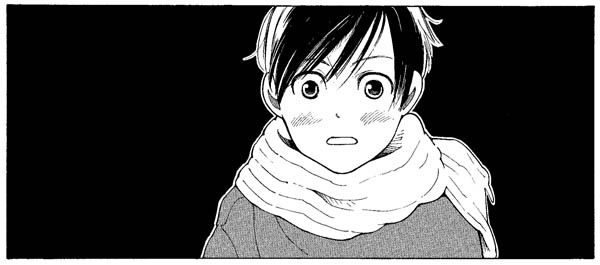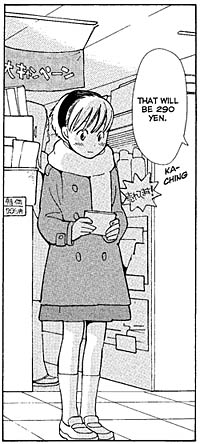 By Shimura Takako
By Shimura Takako
208 pages, black and white
Published by Fantagraphics
If you’d told me a decade ago that Fantagraphics would be hand selecting manga to publish in North America, I’d have laughed at you. But as more publishers dip into the wide spectrum of comics published in Japan, it’s a delight to see Fantagraphics bringing over books like Moto Hagio’s A Drunken Dream and Other Stories, and now Shimura Takako’s series Wandering Son. Because as much as I enjoyed A Drunken Dream, it’s this gentle, inviting series about two transgendered elementary school students that has truly captured my attention.
Wandering Son feels at times more like a series of character sketches that all connect together than a narrative-driven book, but it’s a structure that makes me that much more intrigued, letting us catch glimpses into the lives of Shuichi Nitori and Yoshina Takatsuki. Shuichi is a young boy transferring into a new school in the 5th grade, even as he’s mistaken as a girl because of his soft, delicate demeanor. At the same time, in his class is Yoshina, the tough, more forceful girl that Shuichi slowly forms a bond with, because of their growing understanding of being uncomfortable with their gender. And what begins as a quick crossdressing experiment slowly begins to grow into something greater, and with it, the size of the story expands as well.

Shuichi dominates the early chapters of Wandering Son Vol. 1, and he’s the one that I find much more fascinating of the pair of characters. Unlike Yoshino, Shuichi is initially much more unsure of his life and what’s going on around him. He seems to almost stumble into his understanding of being physically born into the wrong gender; it’s a combination of teasing from his fellow students and a perhaps innocent mistake that finally starts leading him down that path. But at the same time, it’s curious to see Shuichi on the first steps of a journey that everyone else seems to already have plotted out for him. Family members tell him, "You should have been born a girl," in an almost casual manner, and it’s those little cultural differences (I can’t imagine that same sort of scene in an American comic) that help set Wandering Son apart from its peers. Perhaps once Shuichi comes out to family members things will change with them, but for now it’s a curious and almost sweet series of events.
 Shuichi’s relationship with Chiba, in particular, gets the book moving as she encourages him to dress like a girl and even buys him a dress to wear. Even as she comes across supportive and encouraging, I like that Takako keeps Chiba’s motives at least partially hidden. I keep waiting for the other shoe to drop, and it’s that nervousness and uncertainty coloring the relationship between Shuichi and Chiba that helps make Wandering Son feel especially real. No matter how much you want to trust, those early days in understanding your sexuality and how it differs from your friends can be fraught with tension and fear, and Takako brings that to life to a greater audience here.
Shuichi’s relationship with Chiba, in particular, gets the book moving as she encourages him to dress like a girl and even buys him a dress to wear. Even as she comes across supportive and encouraging, I like that Takako keeps Chiba’s motives at least partially hidden. I keep waiting for the other shoe to drop, and it’s that nervousness and uncertainty coloring the relationship between Shuichi and Chiba that helps make Wandering Son feel especially real. No matter how much you want to trust, those early days in understanding your sexuality and how it differs from your friends can be fraught with tension and fear, and Takako brings that to life to a greater audience here.
By way of contrast, Takako’s depiction of Yoshino is much more confident and self-assured, and it makes a good contrast for Shuichi. As we see the flip side of Shuichi in her, though, Takako makes sure to begin to give Yoshino depths as well. Her vulnerability shows up at several unexpected moments, and it ends up feeling somewhat heartbreaking as we see that even Yoshino’s tough exterior has some cracks. Still, while Chiba gets the ball initially rolling in Wandering Son, I keep getting the impression that Yoshino’s purpose here is to move the story (and especially Shuichi) into places that Chiba herself could never reach.
As a narrative, Wandering Son feels at times a little piecemeal. Events are often happening just off-panel, referred to but never actually witnessed. There were a couple of moments the first time I read the book where I felt like I’d accidentally skipped a page, only to take a closer look and realize that Takako had deliberately skipped past them and into the aftermath. The more you read Wandering Son, though, the more it becomes an attraction rather than a detriment. Not only does it help illustrate the idea of this being bits and pieces of a larger life, but just like the real world, you can’t always see everything that happens. Catching only flashes of Yoshino’s fight with a classmate, for example, ends up being much more interesting than if we’d seen every last insult or punch. You can still piece together what happened, but in some ways it ends up being more vivid because of the elements that you have to add in yourself. Insults become much more cruel when you have to come up with the specific word or phrase yourself. There are some times where I do feel like we’re at a slight cultural disadvantage (I’ve heard of the manga The Rose of Versailles before, by way of example, but I feel like not having read it makes me miss on some of the significance of Shuichi and Yoshino’s class performing the play), and that’s the one time where the gaps don’t work quite so well. Translator Matt Thorn’s explanation of honorifics and pronouns in the back of the book, though, is truly fascinating reading and shows how much more meaning there is to the "-kun" and "-chan" suffixes that are thrown around in manga.
Takako’s art is beautiful here, delicate line drawings that fit well with her story. While panels are often lacking in backgrounds, it’s the only complaint I have with her art. So much of the book hangs on the transformations of Shuichi and Yoshino, and it’s there in particular that the book shines. Shuichi dressing as a girl looks so right that it’s hard to feel like it could be anything else. Not just in terms of the clothing fitting, but Shuichi’s actual physical demeanor. Despite Shuichi’s inner nervousness, for the first time Shuichi actually looks alive rather than trying to withdraw into a shell; it’s the visual slow birth of confidence that gives this book so much hope.
Last but not least, props need to go to Fantagraphics for a great physical design of the book. From the attractive cover design and the light (but sturdy) paper stock, to the strong reproduction of the color pages in the volume, Wandering Son Vol. 1 looks attractive in your hand or on the bookshelf. It’s nice to see so much care taken to make this an inviting-looking book. The second volume of Wandering Son is currently set for the end of the year, and I’m definitely going to be reading it as soon as it’s published. This isn’t quite like anything else on the market right now, and I’m thrilled to see Fantagraphics exposing it to a wider audience.
Purchase Links: Amazon.com | Powell’s Books
